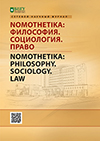HUMAN PROJECTION: THE LIMITS OF POSSIBLE AND IMPOSSIBLE
DOI:
https://doi.org/10.18413/2712-746X-2020-45-1-148-157Keywords:
reflexion, transgression, project, existence, human, consciousness, subject, possible, impossibleAbstract
In the 21 century anthropological reflection faces the problem of an ontological gap between the transformation
of modern man and the possibilities of his self-knowledge to correlate the power of technological
gnosis with the conditions of his existence and the projections of consciousness. The article presents
an existential-phenomenological analysis of the limits of anthropological design from the perspective of
the possible and impossible. The author offers the concepts of anthropological shape and anthropological
content, which form a projective circle: the understanding of one’s being as a human being is inseparable
from being itself. The existential structures of this circle are reflexivity, historicity, transcendence and
transgression. Projectivity becomes a condition of human self-understanding. The human projectivity is a
complex phenomenon that is revealed on the existential and reflexive levels of human existence. The first
level creates the basis of human subjectivity, the second creates an opportunity for project activities. It is
concluded that under the conditions of radical anthropological transformations, the existential way of the
being-historical structure remains a renewable project of human self-understanding.
Downloads
References
Батай Ж. 2006. «Проклятая часть»: Сакральная социология. Пер. с фр. М., Ладомир, 742 с. (Bataille G. La Part Maudite. Paris, Minuit. 1999. 232 p).
Веряскина В.П. 2015. Трансформация человека в обществе модерна. М., ИФ РАН, 223 с.
Генисаретский О.И. 2016. Философия проектности: Из истории проектной культуры второй половины ХХ века. М., URSS; ЛЕНАНД, 400 с.
Дескола Ф. 2012. По ту сторону природы и культуры. Пер. с фр. М., Новое литературное обозрение. 584 с. (Descola P. Par-delà nature et culture. Paris, Gallimard. 2005. 623 p.)
Дорофеев Д.Ю. 2007. Суверенная и гетерогенная спонтанность. СПб.: Изд-во СПбГУ. 672 с.
Каштанова С.М. 2016. Трансгрессия как социально-философское понятие: дис. ... канд. философских наук: 09.00.11. СПб. 203 с.
Кожев А.В. 2003. Введение в чтение Гегеля. Пер. с фр. СПб.: Наука. 792 с. (Kojève A. Introduction a la lécture de Hegel. Paris, Gallimard, 1947. 714 p.
Резник Ю.М. 2016. Феноменология человека: бытие возможного. М.: Канон+. 632 с.
Рябушкина Т.М. 2011. Круг рефлексии: в поисках выхода. Философские науки. № 4: 128–142.
Савчук В.В. 2012. Топологическая рефлексия. М., Канон+, 2012. 416 с.
Сартр Ж.-П. 2009. Бытие и ничто: Опыт феноменологической онтологии. Пер. с фр. М., АСТ. 925 с. (Sartre J.-P. L'être et le néant: Essay d'ontologie phénoménologique. Paris: Gallimard, 1943)
Смит Р. 2014. Быть человеком: историческое знание и сотворение человеческой природы. Пер. с англ. М., Канон+. 368 с. (Smith R. Being human: historical knowledge and the creation of human nature. New York, 2007. 288 p.)
Фаритов В.Т. 2016. Трансгрессия и трансценденция как онтологические перспективы дискурса: дис. … док. философских наук. Ульяновск. 317 с.
Фуко М. 1994. Слова и вещи. Археология гуманитарных наук. Пер. с фр. Спб., A-cad. 408 с. (Foucault M. Les mots et les choses. Une archéologie des sciences humaines. Paris, Gallimard, 1966. 400 p.)
Фуко М. 2002. Что такое Просвещение? В кн.: Интеллектуалы и власть: Избранные политические статьи, выступления и интервью. Пер. с фр. М., Праксис. С. 335–360. (Foucault M. Qu'est-ce que les Lumières? Dits et Ecrits, T. IV. Paris, 1984. Pp. 562-578).
Хабермас Ю. 2003. Философский дискурс о модерне. Пер. с нем. М., Весь Мир. 416 с. (Habermas J. Der philosophische Diskurs der Moderne. Frankfurt am Main, Suhrkamp Verlag. 1985. 450 р.)
Хайдеггер М. 2001. Основные проблемы феноменологии. Пер. с нем. СПб.: Высшая религиозно-философская школа. 446 с. (Heidegger M. Grundprobleme der Phanomenologie. Frankfurt am Main, Vittorio Klostermann Verlag. 1976. 273 р.)
Хайдеггер М. 2013. Бытие и время. Пер. с нем. М.: Академический проект. 460 с. (Heidegger M. Sein und Zeit. Tübingen, Max Niemeyer Verlag. 1967. 450 р.)
Ямпольский М. Настоящее как разрыв. Заметки об истории и памяти. НЛО, 2007. № 83. URL: http://magazines.russ.ru/nlo/2007/83/ia6.html (Дата обращения: 28.12.2018).
Jackson M., Piette A 2015. What is Existential Anthropology? New-York: Berghahn Books,. 254 p.
Who Comes After the Subject? Ed. by E. Cadava, P. Connor, J.-L. Nancy. New York: Routledge, 1991. 258 p.
Abstract views: 698
Share
Published
How to Cite
Issue
Section
Copyright (c) 2020 NOMOTHETIKA: Philosophy. Sociology. Law

This work is licensed under a Creative Commons Attribution 4.0 International License.


